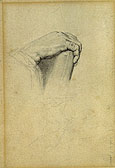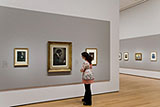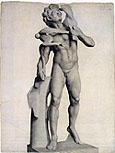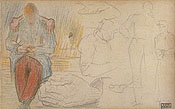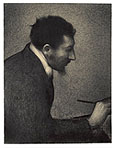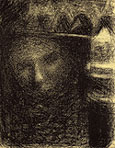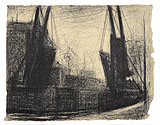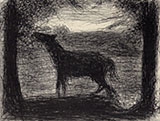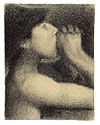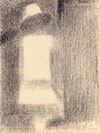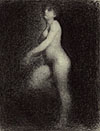The browser will either open the file, download it, or display a dialog.
|
|
Georges Seurat: The Drawings |
|||||
|
The first work in the marvelous exhibition of Georges Seurat's drawings at the Museum of Modern Art, New York, depicts a man's hand emerging from a loose cuff, its pinky finger encircled by a gemmed ring, a tome or thick portfolio in its grasp. The drawing, titled The Hand of Poussin, after Ingres (c. 1875-1877), dates from the early years of Seurat's brief career, when the artist was in his mid-teens, fifteen or so years before his untimely death from diphtheria in 1891, age thirty-one (fig. 1). Unlike the tenebrous works that characterize Seurat's mature oeuvre, drawings in which images emerge from jumbled webs of lines or subtly gradated veils of black, this drawing testifies to a student's effort to immerse himself in tradition, in particular, the tradition of the Beaux-Arts education prescribed to young artists during the nineteenth century. | |||||
| All carefully delineated line and subtle chiaroscuro, The Hand of Poussin, after Ingres is a study of a detail of Ingres's monumental 1827 Apotheosis of Homer (Musée du Louvre, Paris), which was installed as a ceiling decoration in the one of the Louvre's newly dedicated Egyptian and Etruscan antiquities galleries. How telling that in copying a detail that Ingres himself had copied from Poussin's Self-Portrait, Seurat focused his attention on Poussin's hand, the conduit through which creativity is made manifest. An inscription in Seurat's handwriting in the lower-right corner of the drawing states unequivocally "voilà le genie," the implication being that here, in the master's hand, resides his genius; by replicating the detail from Poussin's painting, the copyist, be it Ingres or Seurat, gains access to that genius. Through the precise line and careful shading of the drawing, Seurat states his artistic affinities, both to the aesthetic of the Beaux-Arts tradition, and to the genius of classical French art.1 | ||||||
| The Hand of Poussin, after Ingres is but one of 138 works in the exhibition at MoMA, including over 100 drawings, ten small plein air oil sketches, and a handful of finished paintings. As Seurat's drawings are fragile, their medium often instable, and their paper prone to darkening, exhibitions of these works are rare. The last exhibition dedicated exclusively to Seurat's drawings took place in Germany over twenty-five years ago, and its catalogue was not translated. The large show at the Metropolitan Museum of Art, New York that commemorated the centenary of Seurat's death included a wealth of drawings, but they were, for the most part, presented as auxiliaries to the paintings, with little attention paid to examining the works on their own terms. Seurat's drawings have been due another viewing for some time, and the exhibition at MoMA strives to re-examine this crucial aspect of Seurat's art in a more analytical light than previous exhibitions. In organizing the exhibition, Jodi Hauptman, Associate Curator at MoMA, strikes a balance between the pleasure of viewing such sublime drawings, and a more critical strategy in which the works are situated in the context of the social history that informs their imagery. In addition, the exhibition afforded conservators the opportunity to study the four drawings in MoMA's collection prior to installation, a process that offered novel insights into Seurat's choice of materials and working methods. | ||||||
|
The exhibition is beautifully installed in MoMA's sixth floor galleries (fig. 2). The vast expanse has been reconfigured into an enfilade of smaller galleries, with grey panels mounted on the gallery walls to diminish the scale of a space that has, since its inauguration, housed both James Rosenquist's F-111 (1964-1965), a painting the length of a fighter plane, and a number of Richard Serra's colossal sculptures. An even, moderate light fills the galleries, unifying the white and grey of the walls with the black and beige of the drawings, thus focusing the viewer's attention on the works themselves, not the surrounding space. To enter the exhibition is to be drawn into a wondrous environment, led from one marvel to another as if under the sway of a preternatural beauty. Seurat's work looks splendid on 53rd Street. | |||||
| The exhibition is hung chronologically, starting with Seurat's student work. Upon entering Henri Lehmann's studio at the Ecole des Beaux-Arts in 1878, Seurat embarked on an education that emphasized drawing from plaster casts of antique sculpture and live models. The exhibition at MoMA includes several examples of Seurat's academic drawings, including the fine Antique Statue, Satyr with Goat (1877-1879) from the Dian Woodner Collection (fig. 3). Like Seurat's other académies, this drawing is characterized by a sharp silhouette surrounding finely gradated cross-hatching that defines a contoured, three-dimensional form. Although his academic drawings are proficient, Seurat consistently ranked low in his classes. In March 1878, he placed seventy-seventh out of the eighty students in his drawing class and, showing a bit of improvement a year later, in 1879 he was forty-seventh out of seventy in the overall ranking of students in Lehmann's studio. | ||||||
| By November 1879, when Seurat quit the École to serve a year of military conscription in Brest, he had absorbed the tenets of the Beaux-Arts education to such an extent that they served as a springboard from which to launch an investigation of the wealth of novel ideas that would soon form the basis of his Divisionist aesthetic. On display at MoMA are four sketchbooks that Seurat used during his year of military service. They sit in a vitrine beside two computer monitors that allow viewers to thumb through scanned images of the sketchbook's pages. What a fine idea to use digital imagery to access the sketchbooks, for within their covers are scattered the seeds of Seurat's mature work! Doubled-over laborers and long-limbed dandies in top hats, craggy, bare branches and lumpish horses, women reading and soldiers engaged in domestic tasks, all are Naturalist subjects that will figure prominently in Seurat's mature drawings. On those occasions when Seurat uses color in his sketchbook jottings, he draws on an incipient awareness of chromatic contrasts that was to play such an important role in his paintings. For instance, in a sketch of a seated soldier from 1879-1880, a green outline contains the reddish-orange of the soldier's trousers; his purple kepi sits at his side, engulfed in a hatched yellow field, its red pompom encircled with a stroke of green (fig. 4). Robert Herbert describes the importance of the Brest sketchbooks: "He [Seurat] applied his lessons to naturalistic subjects, and learned to pick out the most characteristic elements, to concentrate upon the most crystalline and economic expression of form."2 The sketchbooks bridge Seurat's academic education and the innovative works that define his Divisionist aesthetic, those drawings and paintings created between the early 1880s and his death in 1891. | ||||||
| Shortly after his twenty-third birthday, Seurat exhibited the portrait of his friend and classmate, Edmond-François Aman-Jean, one of the great portraits of the nineteenth century. The critic Roger Marx described it as "…an excellent study in light and dark, a meritorious drawing that cannot be the work of a newcomer."3 Newcomer or not, Aman-Jean (1882-1883) shows Seurat fully in command of the technique that characterizes the 230 or so drawings he created during the decade of his artistic maturity (fig. 5). Abandoning the Beaux-Arts contour line, Seurat employed a novel technique in which he stroked conté crayon across the ridges of laid Michallet paper, layering pigment to create a wide range of densities, from the faintest scrim of interlacing lines to a deep, impenetrable black, a process that emphasizes the contrast of light and dark in order to abstract and simplify shapes and figures. This is a drawing of juxtapositions, of the subtlest opposing tones lying in proximity to one another, their difference heightened with a soft halo of light. By 1883, when Seurat exhibited the portrait of Aman-Jean, he had discovered, in the words of Hauptman, "…that modernity is not served by the contour line," thus rejecting one of the rudimentary principles of his education. (113). | ||||||
| The painter Paul Signac described Seurat's drawings as "…the most beautiful painter's drawings in existence."4 Take, for instance, The Lamp (1882-1883), its shadowy face emerging from darkness, crowned by the zigzag of a fluted lampshade (fig. 6); or, the ominously looming Drawbridge (1882-1883), the atmosphere surrounding its forked arms made palpable through skeins of jumbled lines (fig. 7); or, the unbridled energy of the Lehman Collection's Foal (1882-1883), its legs an vigorous flurry of conté crayon (fig. 8). Seurat also drew numerous studies for finished paintings such as Une Baignade, Asnières (1883-1884) and Une Dimanche à la Grande Jatte (1884-1886), one a close-up a boy with his hands cupped to his mouth as he lets out a silent call, another a small girl placidly holding her mother's hand, the white of her dress and hat negative space untouched by the vertical strokes of the conté crayon (figs. 9, 10). Seurat's drawings exhibit a fascination with the effects of luminosity. They deliberately tread the hairline between description and evocation. They embody a radical attempt to return order and solidity to composition, casting aside the bravura brushwork and fleeting visions of the Impressionists in favor of a timeless art, an art in which, to borrow words from Seurat's famous analogy with the figures of the Parthenon frieze, "…people move about as on these friezes, in their most essential characteristics."5 | ||||||
| The exhibition catalogue contains several insightful essays, in particular, one by Hauptman's discussing the pull that the liminal zones surrounding Paris exerted on Seurat and his work, and another by Karl Buchberg, Senior Conservator at MoMA, on recent discoveries concerning the materials and techniques of Seurat's drawings. These essays mark the forefront of two of the most innovative approaches scholars are currently using to study Seurat's art. While an opportunity to see Seurat's drawings is surely reason enough to mount an exhibition of them, the scholarship in Hauptman's and Buchberg's essays elevates the exhibition to the status of a watershed in the study of Seurat's graphic oeuvre. It will inspire future generations of art historians to embark on numerous paths of inquiry in the study of Seurat's drawings. | ||||||
| The catalogue's greatest weakness, however, is its lack of catalogue entries. A handful of the drawings are discussed in the essays, but there is no systematic, in-depth explication of the works on display, thus diminishing the value of the catalogue as a research tool. It would be interesting to know the rationale behind Hauptman's decision to hang the drawing Nude (1881-1882), with its curvaceous woman emerging from a velvety-black background of meandering lines, in the midst of a gallery of incisive, linear academic drawings (fig. 11). Robert Herbert dates the drawing "c. 1879," characterizing it as an experimental work created shortly after Seurat set up his studio in Paris upon returning from Brest, a youthful experiment with the dark, nebulous style of Fantin-Latour's lithographs.6 Henri Dorra questions Herbert's dating of the drawing, presenting a more complex and, ultimately, a more plausible scenario in which Seurat sketched a contour drawing of a nude woman shortly after returning to Paris, put the sketch aside, then, a few years later, reworked the sketch, adding the dark, massy shading so characteristic of his work from the early-1880s.7 As Hauptman chose to hang the drawing in the company of a number of academic studies, she certainly has given some thought to the drawing's style and dating, yet the logic behind its anachronistic placement is not explained, either in the wall text in the gallery or in the catalogue essays. A catalogue entry could address specific issues such as this one, making for a richer, more expansive understanding of what makes art history such a dynamic discipline. | ||||||
| Despite their beauty, there is a contradictory element to Seurat's drawings. Throughout his brief career, Seurat strove to create art defined by the rational, the scientific. His art is informed by the most empirical scientific work of the day, be it the color theories of Michel-Eugène Chevreul and Ogden Rood, or the perceptual ideas of Charles Blanc, Humbert de Superville, and Charles Henry. Yet, as Bridget Riley notes in the final essay in the catalogue, "Comprehension is not everything, the unaccountable has a place in our lives, particularly in that of an artist" (195). How telling that an artist who toiled with such perseverance to align his art with science created drawing after drawing that purposefully toys with the ambiguity inherent in the conventions of representation. In acknowledging the murkiness that Seurat's drawings never shake, Riley puts her finger on the crux of the matter, the very wonder of Seurat's art: "Seurat… has presented us with the mysterious. No longer located in subject matter, in dusk or moonlight, in half-seen faces or shrouded figures, this unknown seems to have changed places, to have moved back to us, to be part of us. It lies here in our own powers of sight, emerging as one of the great mysteries and delights of being alive" (195). The exhibition of Seurat's drawings at MoMA is magnificent, every wall, from first to last, hung with images profoundly mysterious and as delightful as can be. | ||||||
| Michael Dorsch Assistant Professor of Art History, The Cooper Union for the Advancement of Science and Art, New York michaeldorsch[at]earthlink.net |
||||||
|
1. A full catalogue entry on Seurat's drawing, The Hand of Poussin, after Ingres, can be found in Robert L. Herbert. Georges Seurat, 1859-1891. Exh. cat. (New York: The Metropolitan Museum of Art, 1991), Catalogue #3. 2. Seurat's drawing, The Hand of Poussin, after Ingres, can be found in Robert L. Herbert. Georges Seurat, 1859-1891. Exh. cat. (New York: The Metropolitan Museum of Art, 1991), Catalogue #3. 3. Roger Marx. "Le salon, VI (fin)," Le progress artistique (15 June 1883), n.p.; quoted in Herbert 1991, p. 49. 4. Paul Signac. D'Eugène Delacroix au Néo-Impréssionisme, 4th ed. (Paris: Librarie Floury, 1939), 81. 5. Quoted in Gustave Kahn. "Exposition Puvis de Chavannes," La Revue Indépendante (1888), 142; reprinted in Herbert 1962, 124. 6. Herbert 1962, 24-25. 7. Henri Dorra. "Review: Seurat's Drawings by Robert Herbert," The Art Bulletin 53, 2 (June 1971), 271; Herbert 1962, fig. 22, illustrates just the kind of line drawing that Dorra suggests Seurat drew in the late-1870s, then returned to a few years later, reworking the line drawing into a finished work such as Nude (1881-1882). |
||||||


